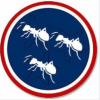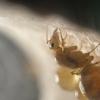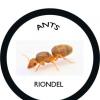I've kept a few pavement ants, and I've kept them in a few different types of formicariums and they ALWAYS escape.
Does anyone have any recommendations for formicariums that can keep the smaller species?

I've kept a few pavement ants, and I've kept them in a few different types of formicariums and they ALWAYS escape.
Does anyone have any recommendations for formicariums that can keep the smaller species?
I've kept a few pavement ants, and I've kept them in a few different types of formicariums and they ALWAYS escape.
Does anyone have any recommendations for formicariums that can keep the smaller species?
THA mini hearths work pretty well, even for tiny escape artists like Monomorium and Pheidole.
"Float like a butterfly sting like a bee, his eyes can't hit what the eyes can't see."
- Muhammad Ali
Check out my shop and cryptic ant journal! Discord user is bmb1bee if you'd like to chat.
Also check out my YouTube channel: @bmb1bee
Well, I have ordered a Wakooshi nest for my new colony of small ants, since it comes with the bold promise "All our new generation nests are totally escape proof for small and tiny ants!"
The nest is still on the way, but I will report back if the promise holds true or is false advertising.
Plus Tarheel ants is promising that their nests for small and tiny ants, if you order the upgrade for small and tiny ants, will be escape proof. So far my Lasius niger have not escaped from my mini hearth, but they are not really small small and I did not order the upgrade with the extra strong magnets and extra tight fit.
But I know the pain- my Temnothorax escape all the time. I have no idea where they come out. It is not a real problem because they are so harmless, but every single day I will be picking up one scout who is walking around happily outside the enclosure. I am pretty sure these ants can walk through walls.
Containing Small Ants
Hello JoeByron;
I make all my formicaria, here's a few things I've learned along the way.
Start with an acrylic container that has a lid with a positive closing feature like those used in spice and other food containers. Whatever container I choose, the lid must be tight fitting yet easily opened. Rubber seals are a must for very small escape artists. The acrylic in the walls of the container should be thick enough that it will hold tubing securely, even without glue.
Tubing connects several chambers of this Tetramorium colony. A queen chamber and brood chamber on the left, connect to the liquids feeding station in the middle and the outworld feeding station on the right. The wire hook is supposed to be holding the tubing at a constant slope to make travel easier for the ants, but still a long enough trip to keep them occupied.
A lever action lid on these food containers makes an escape proof seal on the center chambers of this Tetramorium colony. An acrylic container with an easy to remove lid on the left is the feeding outworld. The two containers in the middle are brood chambers and on the right is the queen chamber.
A feeding port limits the area for ants to escape during feeding, blowing on them usually makes mine retreat and clear the feeding area. Oil on the inside of the opening also limits escape attempts.
Screen must be the right size for the species. I use stainless steel mosquito screen for Camponotus, and 100 mesh stainless steel for Tetramorium. I've used a fine nylon mesh screen quite successfully until last year when a Tetramorium colony chewed through it while I was on vacation. Now they get stainless steel for sure, but the nylon screen is working well for all my other small ants. I also hot glue screen on the outside of the container to minimize the chances of ants chewing through glue and escaping under the screen.
Tubing should fit tightly into drilled holes, connectors and other tubing - tight enough that escape isn't possible, even without glue. I do hot glue most of my tubing in place and I use rubber stoppers to plug unused openings. All connections should be visible and regularly inspected.
Temnothorx in confinement housing. Small bottles with covers house the colonies in most of these setups and the acrylic box or container they're attached to is the outworld.
I use heavy mineral oil (I buy it at the pharmacy) for containment of large and small ants. I think ants climbing on the walls of the formicarium is undesirable and unnecessary. To reduce climbing, I wipe a thin coating of heavy mineral oil on all inside wall surfaces before final construction. This provides a nice slick surface that discourages climbing. I back that up with a strip of oil applied to the bottom of walls, or anywhere ants have access to the wall. Some ants stick things to it, but it's very easy to wipe off and keep clean or sometimes I clean only the front panel for viewing.
These colonies sit on a partly sunny window. They warm quite nicely in summer when a large tree out back is in leaf, but at this time of year I shade them to prevent overheating.
I hope this helps, I'm happy to answer any questions you may have.
RPT
Ant Keeping →
General Ant Keeping →
What should I use for DIY?Started by AntsGodzilla , Sep 18 2024 |
|

|
||
Market Place →
General Market Place →
Venom's FormicariumsStarted by VenomousBeast , Jan 15 2023 |
|

|
||
Ant Keeping →
Ant Keeping Journals →
antsriondels coloniesStarted by antsriondel , Dec 3 2021 |
|

|
||
Ant Keeping →
General Ant Keeping →
FireBrick DIY FormicariaStarted by UtahAnts , Aug 30 2021 |
|

|
||
Ant Keeping →
General Ant Keeping →
Best Router tool for wood formicariumsStarted by UtahAnts , Apr 9 2021 |
|

|
0 members, 1 guests, 0 anonymous users